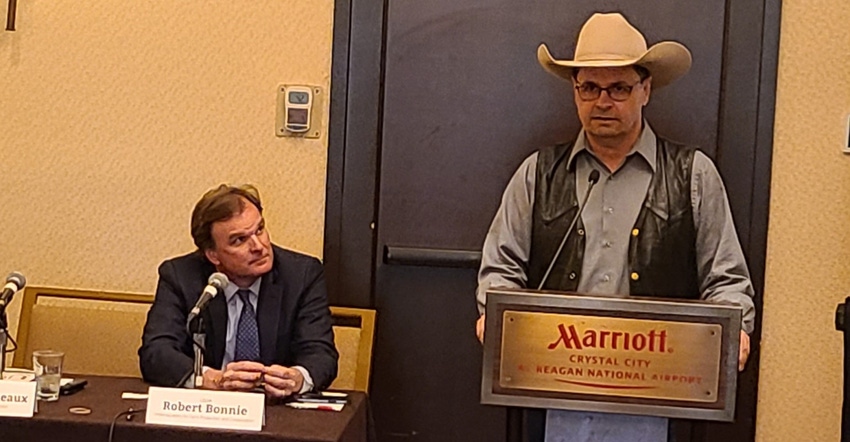Producers will have until fall to make final determination on whether or not to go forward with new CRP contracts.

USDA is accepting more than 2 million acres in offers from agricultural producers and landowners through the Conservation Reserve Program general signup, the first of the program’s multiple signups occurring in 2022. Farm Service Agency Administrator Zach Ducheneaux says about 90% of enrolled acres were accepted, and the agency hopes to encourage producers to consider additional enrollment options in the Grassland and Continuous signups, both of which are currently open.
“Our conservation programs are voluntary, and at the end of the day, producers are making market-based decisions as the program was designed to allow and encourages,” says Secretary of Agriculture Tom Vilsack in a statement. USDA has been under pressure by some to allow for early release of contracted CRP acres to encourage additional production with potential Ukrainian shortfalls. An estimated 3.4 million acres of enrolled CRP acres expired this year.
Producers submitted re-enrollment offers for just over half of expiring acres, similar to the rate in 2021. Offers for new land under General CRP were considerably lower compared to last year’s numbers, with fewer than 400,000 acres being offered this year versus over 700,000 acres offered last year. Contracts for land enrolled in CRP last from 10 – 15 years in length.
It is important to note that submitting and accepting a CRP offer is the start of the process, and producers still need to develop a conservation plan before enrolling their land on Oct. 1, 2022, USDA says. Each year, during the window between offer acceptance and land enrollment, some producers change their mind and ultimately decide not to enroll some accepted acres without penalty. Ducheneaux explains the benefits of a voluntary and incentive-based program such as CRP gives producers another economic option from which to plan for their future.
For farmers who have decided to return all or a portion of their land into production agriculture, USDA will also be reaching out to ensure they understand and can take advantage of options to either prepare the land for production or transition it to beginning farmers, USDA says.
The week prior, Undersecretary of Farm Production and Conservation Robert Bonnie says USDA is not considering allowing any fieldwork prior to the official expiration of the CRP contracts at the end of September. He recognizes that USDA expects reduced demand for CRP enrollments because of the higher market prices, but also anticipates tailored enrollments, especially in those areas hit hard by drought.
Expanding CRP acreage
Ducheneaux says the current CRP cap is at 25.5 million acres in 2022, so there is room to continue the momentum of signups in the Grasslands, Continuous and Conservation Reserve Enhancement programs with the 3.4 million acres expiring this year.
These three other types of CRP are still available for either working-lands or targeted, often smaller sub-field, offers. Producers have submitted offers on nearly 260,000 acres through the Continuous and CREP signup so far this year. The Grassland signup – which last year had its highest participation ever – closes May 13, 2022.
The continuous signup enrolls more vulnerable acres on an ongoing basis. The Grasslands program is considered more of a working-lands program because producers can graze on the land.
Ducheneaux also explains the “reserve” part of the Conservation Reserve Program continues to be available in emergency haying and grazing situations. “I would offer that we’re not taking CRP land out of production, we are changing the nature of production on it,” he explains. “As an example, last year, all across the northwestern part of the United States down into the midsection and West, producers were able to use the reserve aspect of the Conservation Reserve Program to help keep their cattle herds together through emergency haying and grazing.”
And Ducheneaux says this isn’t just in the times of desperate need. There have been changes made to CRP that allow the harvesting of forage either through mechanical or animal grazing in normal years. This allows producers to stockpile forage for when that disaster does hit. FSA put out a two-page fact sheet on what is allowed under non-emergency haying and grazing, which requires approval from the local FSA office.
In 2021, FSA introduced improvements to CRP, which included a new Climate-Smart Practice Incentive to increase carbon sequestration and reduce greenhouse gas emissions. This incentive provides a 3%, 5% or 10% incentive payment based on the predominant vegetation type for the practices enrolled – from grasses to trees to wetland restoration.
In the past, the National Association of Conservation Districts has applauded USDA’s efforts to encourage participation in CRP by increasing payment rates and introducing a variety of incentive payments, including a climate incentive payment.
“NACD is pleased more than 2 million acres have been accepted through CRP and looks forward to USDA continuing its excellent stewardship of this program,” says NACD CEO Jeremy Peters. “CRP plays a key component to conservation, and we are excited to see enrollment options become available to as many eligible producers as possible, particularly those who manage vulnerable lands.”
About the Author(s)
You May Also Like



.png?width=300&auto=webp&quality=80&disable=upscale)

